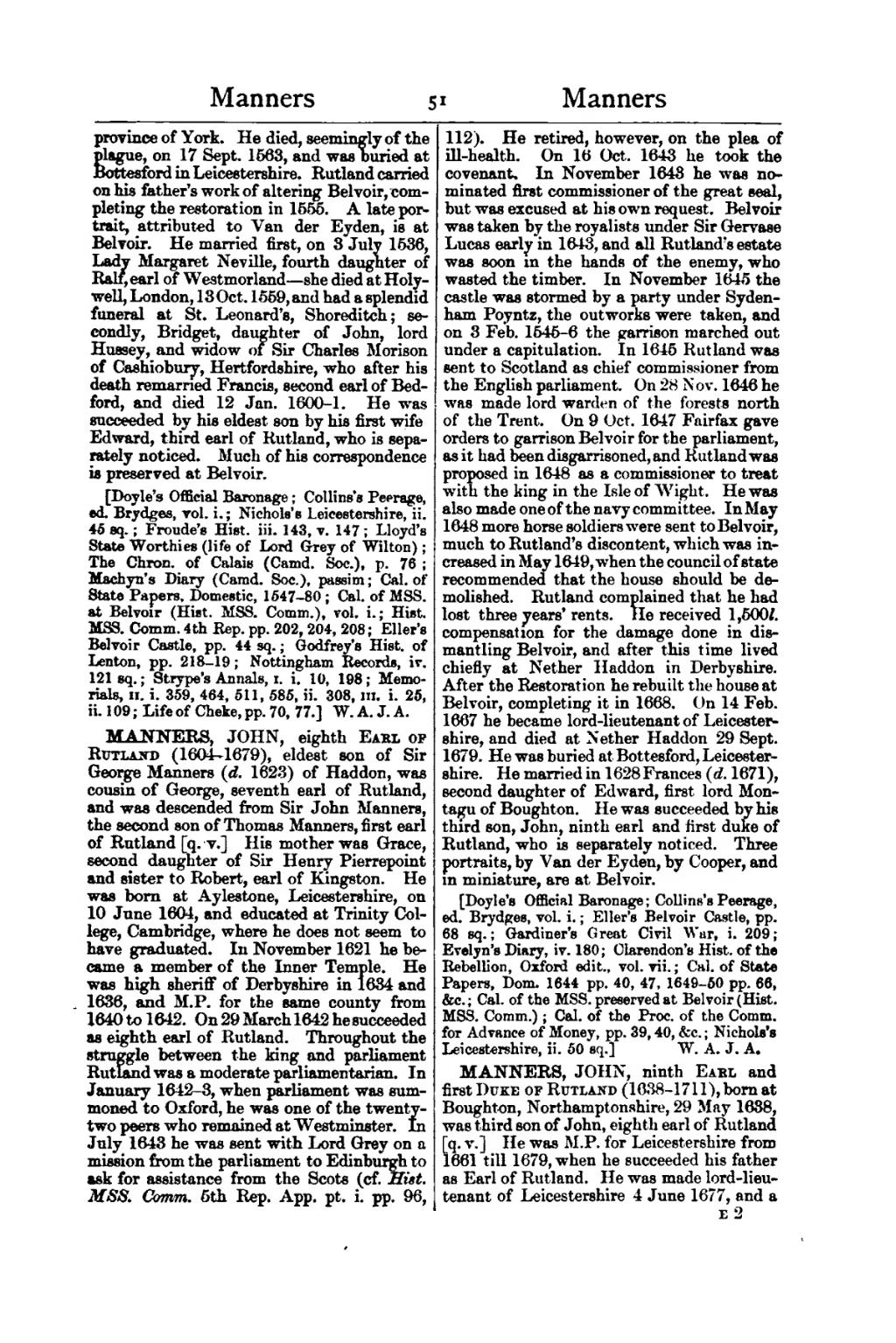province of York. He died, seemingly of the plague, on 17 Sept. 1563, and was buried at Bottesford in Leicestershire. Rutland carried on his father's work of altering Belvoir, completing the restoration in 1556. A late portrait, attributed to Van der Eyden, is at Belvoir. He married first, on 3 July 1536, Lady Margaret Neville, fourth daughter of Ran, earl of Westmorland — she died at Holywell, London, 13 Oct. 1559, and had a splendid funeral at St. Leonard's, Shoreditch; secondly, Bridget, daughter of John, lord Hussey, and widow of Sir Charles Morison of Cashiobury, Hertfordshire, who after his death remarried Francis, second earl of Bedford, and died 12 Jan. 1600-1. He was succeeded by his eldest son by his first wife Edward, third earl of Rutland, who is separately noticed. Much of his correspondence is preserved at Belvoir.
[Doyle's Official Baronage; Collins's Peerage, ed. Brydges, vol. i.; Nichols's Leicestershire, ii. 45 sq.; Froude's Hist. iii. 143, v. 147; Lloyd's State Worthies (life of Lord Grey of Wilton); The Chron. of Calais (Camd. Soc.) p. 76; Machyn's Diary (Camd. Soc.), passim; Cal. of State Papers, Domestic, 1547-80; Cal. of MSS. at Belvoir (Hist. MSS. Comm.), vol. i.; Hist. MSS. Comm. 4th Rep. pp. 202, 204, 208; Eller's Belvoir Castle, pp. 44 sq.; Godfrey's Hist. of Lenton, pp. 218-19; Nottingham Records, iv. 121 sq.; Strype's Annals, i. i. 10, 198; Memorials, 11. i. 359, 464, 511, 585, ii. 308, in. i. 25, ii. 109; Life of Cheke, pp. 70, 77.]
MANNERS, JOHN, eighth Earl of Rutland (1604–1679), eldest son of Sir George Manners (d 1623) of Haddon, was cousin of George, seventh earl of Rutland, and was descended from Sir John Manners, the second son of Thomas Manners, first earl of Rutland [q. v.] His mother was Grace, second daughter of Sir Henry Pierrepoint and sister to Robert, earl of Kingston. He was born at Aylestone, Leicestershire, on 10 June 1604, and educated at Trinity College, Cambridge, where he does not seem to have graduated. In November 1621 he became a member of the Inner Temple. He was high sheriff of Derbyshire in 1634 and 1636, and M.P. for the same county from 1640 to 1642. On 29 March 1642 he succeeded as eighth earl of Rutland. Throughout the struggle between the king and parliament Rutland was a moderate parliamentarian. In January 1642–3, when parliament was summoned to Oxford, he was one of the twenty-two peers who remained at Westminster. In July 1643 he was sent with Lord Grey on a mission from the parliament to Edinburgh to ask for assistance from the Scots (cf. Hist. MSS. Comm. 5th Rep. App. pt. i. pp. 96, 112). He retired, however, on the plea of ill-health. On 16 Oct. 1643 he took the covenant. In November 1643 he was nominated first commissioner of the great seal, but was excused at his own request. Belvoir was taken by the royalists under Sir Gervase Lucas early in 1643, and all Rutland's estate was soon in the hands of the enemy, who wasted the timber. In November 1645 the castle was stormed by a party under Sydenham Poyntz, the outworks were taken, and on 3 Feb. 1645–6 the garrison marched out under a capitulation. In 1645 Rutland was sent to Scotland as chief commissioner from the English parliament. On 28 Nov. 1646 he was made lord warden of the forests north of the Trent. On 9 Oct. 1647 Fairfax gave orders to garrison Belvoir for the parliament, as it had been disgarrisoned, and Rutland was proposed in 1648 as a commissioner to treat with the king in the Isle of Wight. He was also made one of the navy committee. In May 1648 more horse soldiers were sent to Belvoir, much to Rutland's discontent, which was increased in May 1649, when the council of state recommended that the house should be demolished. Rutland complained that he had lost three years' rents. He received 1,500l. compensation for the damage done in dismantling Belvoir, and after this time lived chiefly at Nether Haddon in Derbyshire. After the Restoration he rebuilt the house at Belvoir, completing it in 1668. On 14 Feb. 1667 he became lord-lieutenant of Leicestershire, and died at Nether Haddon 29 Sept. 1679. He was buried at Bottesford, Leicestershire. He married in 1628 Frances (d. 1671), second daughter of Edward, first lord Montagu of Boughton. He was succeeded by his third son, John, ninth earl and first duke of Rutland , who is separately noticed. Three portraits, by Van der Eyden, by Cooper, and in miniature, are at Belvoir.
[Doyle's Official Baronage; Collins's Peerage, ed. Brydges, vol. i.; Eller's Belvoir Castle, pp. 68 sq.; Gardiner's Great Civil War, i. 209; Evelyn's Diary, iv. 180; Clarendon's Hist. of the Rebellion, Oxford edit., vol. vii.; Cal. of State Papers, Dom. 1644 pp. 40, 47, 1649–50 pp. 66, &c.; Cal. of the MSS. preserved at Belvoir (Hist. MSS. Comm.); Cal. of the Proc. of the Comm. for Advance of Money, pp. 39, 40, &c.; Nichols's Leicestershire, ii. 50 sq.]
MANNERS, JOHN, ninth Earl and first Duke of Rutland (1638–1711), born at Boughton, Northamptonshire, 29 May 1638, was third son of John, eighth earl of Rutland [q. v.] He was M.P. for Leicestershire from 1661 till 1679, when he succeeded his father as Earl of Rutland. He was made lord-lieutenant of Leicestershire 4 June 1677, and a
